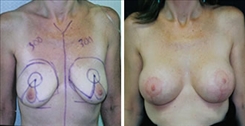BREAST AUGMENTATION WITH CONCURRENT MASTOPEXY – BREAST LIFT
Posted On: July 10, 2014 Author: The Office of Dr. Stuart Linder Posted In: Breast Augmentation, Breast Implants, Breast Lift, Breast topics, Plastic Surgery
As women age, the breasts may become saggier with more skin laxity, especially along the vertical and the inframammary fold regions. This may require a formal mastopexy concurrently with an augmentation mammoplasty procedure. Women in their 30s who have had children and have had weight fluctuations often present with severe ptosis, including grade 3 ptosis requiring a mastopexy using a formal breast lift, that is a Wise-pattern anchor scar. Replacing the involutional upper pole atrophy or complete loss of fullness to the breast with an implant behind the muscle is quite evident and leads to nice fullness. However, tightening the actual skin brassiere by removing skin along the vertical and along the inframammary fold, will allow for a more tight and perkier appearance which most women are hoping to achieve. Women in their 40s often develop loss of skin elasticity which leads to decrease in tightening and the need for tightening procedures, including vertical mastopexies with skin removed along the nipple areolar complex and vertically along the vertical plane for grade 2 ptosis or the formal mastopexy which is the anchor scar, for patients who have increased skin laxity both along the vertical and along the inframammary fold. This is severe grade 3 ptosis where the nipple is greater than 3 cm below the inframammary fold. Board Certified Plastic Surgeons are able to gage which type of breast lift is most appropriate with respect to these degrees of ptosis.

As women enter into their 50s and 60s, simply skin laxity may occur even without significant weight fluctuation. At this time, patients should always wear sports bras during the evening or sleep bras at night, as well as underwire brassieres during the day to help prevent gravitational descent of the breasts and increased involutional upper pole loss of fullness or atrophy of the breast tissue. Women who have been pregnant or are now breast feeding, are postpartum or post breast feeding, also present with severe amounts of skin laxity. They should undergo the appropriate lifts which can be either minimal periareolar crescent lifts for grade 1 ptosis, vertical mastopexy for grade 2 ptosis and grade 3 ptosis, a formal mastopexy using the inferior pedicle Wise-pattern technique when appropriate.
In Dr. Linder’s practice, in the majority of cases, saline and silicone breast implants are placed in the dual plane technique. Then the patient is remarked and the skin is removed, as necessary, either through a vertical lift or a formal breast lift.